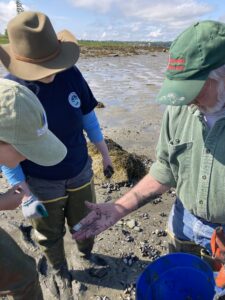Understanding the populations of an important marine resource
Intertidal mudflats are coastal wetlands, expanses of soft sediment swept daily by ocean tides. The soggy substrate of clay and silt is flooded as the water rushes in and then exposed to scorching sun (or freezing winter cold) as the water recedes. Few plants and animals live in this fluctuating environment, but those that do are important to the food web. This includes clams, worms, crabs, and amphipods, accompanied closely by shore birds looking for their next meal.
Bloodworms (Glycera dibranchiata) and sandworms (Alitta spp.) make their homes in such intertidal mudflats. These marine worms are commercially harvested and support the economies of coastal communities. Generations of commercial worm harvesters (wormers) have gathered worms by hand to sell as fishing bait, accumulating valuable observational knowledge about mudflats as they do so. Recently, marine worm populations have plummeted, and both natural resource managers and wormers want to know why.
Alongside local wormers, Department of Marine Resources staff, and the Scientists in Parks program of the National Park Service, Schoodic Institute conducts research to determine how and why commercial worm population structure varies at mudflats in and around Acadia National Park. This research builds on previous work in Acadia’s soft-sediment ecosystems.
Project Timeline
- Late 1980s: Bigelow Laboratory for Ocean Sciences surveys mudflat biodiversity.
- 1991: Technical Report #84 is released, summarizing these surveying efforts.
- 2021: Schoodic Institute/National Park Service (SI/NPS) partnership repeats the biodiversity surveys detailed in report #84 and adds more sampling locations.
- Early 2022: SI/NPS compares gear, refines surveying procedures, and finds that soft sediment biodiversity has declined. Rather than reiterating this biodiversity loss with further surveys, they pivot to focus on where and why marine worm populations declined.
- Late 2022: SI/NPS works with local wormers to better understand worm population structures in mudflats around the park.
- 2023: SI/NPS continues collaboration with local wormers to determine what variables contribute to worm decline in different mudflats, adopting a surveying protocol used by the DMR to better share data between organizations.
- In the future: data will be compared to a highly productive mudflat in Midcoast Maine to inform resource management in the park by identifying areas of healthy and unhealthy population structure.

For more information, contact Hannah Webber, hwebber@schoodicinstitute.org
Project description written by Rebecca Foy.